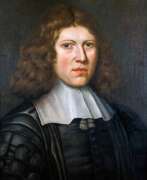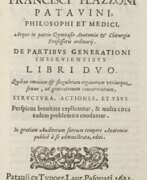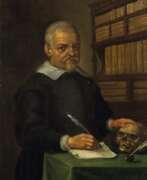Anatomists 17th century


Girolamo Fabrici d'Acquapendente, also known as Girolamo Fabrizio or Hieronymus Fabricius, was an Italian anatomist and surgeon and the founder of embryology. The Latinised form of his name, under which his works can be found, is Hieronymus Fabricius (ab Aquapendente).


Theodor Kerckring (Dutch: Thomas Theodor Kerckring) or Dirk Kerckring was a Dutch physician and anatomist, a member of the Royal Society of London.
Kerckring received his MD degree in Leiden and came to Amsterdam. Here, thanks to his acquaintance with the famous anatomist Ruysch, he took up the study of anatomy, in the field of which he made many remarkable discoveries.
In his book Spicilegium Anatomicum, Theodore Kerckring described and illustrated many anatomical deformities and diseases. Observations also included public health risks. He was one of the first to study the development of the human embryo and the fetal bone system. Kerckring's most important and significant contribution was his discovery that the fetal skeleton develops by the transformation of membrane and cartilage into bone.


Richard Lower was a British physician, anatomist and physiologist who developed methods of blood transfusion.
Lower studied medicine at Oxford, moved to London in 1666 and began practicing medicine, soon becoming a successful physician and a Fellow of the Royal Society. Lower is particularly known for his work on the brain and nerves, which he performed as an assistant to Thomas Willis at Oxford while studying medicine. His anatomical and physiological study of the structure and action of the heart was one of the earliest discoveries, and he himself was recognized as one of the most skilled vivisectors of his time.
Lower was involved in the earliest experiments in blood transfusion, following Christopher Wren's similar studies a few years earlier. In February 1665, Lowther performed the first transfusion of blood from an artery of one animal into a vein of another, and in 1666 he also participated in the first experimental transfusion of blood to man.
Lower was a pioneer of experimental physiology. In his book Tractatus de Corde (1669), he described his pioneering work on blood transfusion and the function of the cardiopulmonary system. Also described is a series of experiments conducted with Robert Hooke in which he showed that the color of arterial blood is due to its contact with "fresh air" in the lungs.


Marcello Malpighi was an Italian biologist, anatomist and physician, professor of logic, theoretical and practical medicine, and a member of the Royal Society of London.
After graduating from the University of Bologna with the degree of Doctor of Medicine and Philosophy, Malpighi soon took up a professorship there, then taught at the universities of Pisa and Messina. At the same time as teaching, he conducted biological research with his microscopes, which was an innovation in those days. In 1661, he identified and described the pulmonary and capillary network connecting small arteries to small veins, one of the most important discoveries in the history of science. He also isolated taste buds and regarded them as nerve endings, described the minute structure of the brain, the optic nerve, and in 1666 was the first to see red blood cells and attribute to them the color of blood. His treatise De polypo cordis (1666) explained the composition of blood and how it coagulates.
During his medical practice, Malpighi studied microscopic sections of the liver, brain, spleen, kidneys, and the bone and deep layers of skin that now bear his name. In his landmark 1673 work on the embryology of the chicken, the scientist concluded that the embryo forms in the egg after fertilization. In 1675-79 he also made extensive comparative studies of the microscopic anatomy of several different plants and saw analogies between plant and animal organisms. The Royal Society of London published two volumes of his botanical and zoological works in 1675 and 1679. His Anatome Plantarum is richly decorated with engravings by Robert White.
After his house was burned and looted by his adversaries, in 1691 Pope Innocent XII invited him to Rome as papal personal physician, which was a great honor.
Malpighi can be considered the first histologist. For almost 40 years he used the microscope to describe the main types of plant and animal structures and thus marked for future generations of biologists the main directions of research in botany, embryology, human anatomy and pathology. The conflict between ancient ideas and modern discoveries continued throughout the seventeenth century. Malpighi was convinced that microscopic anatomy, by showing the minute structure of living things, questioned the value of the old medicine. He laid the anatomical foundation for the subsequent understanding of human physiological exchanges.


Francesco Plazzoni was an Italian physician and anatomist.
Plazzoni was a fellow student of Fabrizi and colleague of Spigellius, and taught in Padua. He is the author of the treatise De partibus generationi inservientibus libri duo (Padua, 1621). His text is based on Plazzoni's anatomical lectures in Padua and deals with the physiology of the penis, the clitoris, and sexual arousal.


Giovanni Dominico Santorini was an Italian anatomist and professor.
Santorini studied medicine in Bologna, Padua and Pisa, earning his doctorate. One of his teachers was Marcello Malpighi (1628-1694). In 1703 Santorini began anatomical autopsies and was a demonstrator of anatomy in Venice from 1706 to 1728. In 1728 he became proto-medic and physician to Spedaletto in that city.
He was considered one of the most industrious and meticulous anatomists of the eighteenth century. Santorini's anatomical studies include many muscular and venous structures, cartilage, and glands of the human body. In addition to detailed descriptions of these structures, he also produced magnificent copper plates and illustrations. In 1724, Santorini published Observationes anatomicae ("Anatomical Observations"), a work that included anatomical aspects of the human body.
Giovanni Santorini's work greatly expanded knowledge of human anatomy, and several organs are named after him. Santorini was also a popular pioneer in the teaching of obstetrics.


Marco Aurelio Severino was an Italian surgeon, anatomist and zoologist, one of the founders of comparative anatomy.
From childhood Severino studied Latin, Greek, rhetoric, poetry and law in various schools in Calabria, then continued his studies in Naples, soon moving from law to medicine. In Naples he met Tommaso Campanella, who had a great influence on the formation of his worldview. After receiving a medical degree in Salerno in 1606, he studied surgery in Naples with Giulio Jasolino. In 1615 Severino was appointed the first surgeon at Ospedale degli Incurabili. Severino made significant contributions to the transformation of naturophilosophy, medical and surgical practice, to which much of his printed work is devoted.
Severino's main contribution, however, lies in his anatomical works, especially the Zootomia Democritea. This work may be called the earliest comprehensive treatise on comparative anatomy. Severino is considered one of the pioneers of comparative anatomy.
Severino's cultural interests extended far beyond medicine. He corresponded with many prominent physicians and scientists of his time, including William Harvey and John Houghton in England, Thomas Bartolin and Ole Worm in Denmark, J.G. Volkamer and Johannes Wesling in Germany, and Campanella, Jasolino, and Tommaso Cornelio in Italy. Severino was tried by the Inquisition for allegedly unorthodox religious and philosophical views, but was eventually acquitted. He died of the plague in Naples.


Jan Swammerdam was a Dutch naturalist and biologist, anatomist and microscopist.
Swammerdam graduated from the Faculty of Medicine at Leiden University, then studied in Paris, earning a doctorate in medicine, and devoted himself exclusively to microscopic research. He used a single-lens microscope to study insect anatomy, and accurately described and illustrated the life history and anatomy of many species. His observations of their development allowed him to divide insects into four major divisions according to the degree and type of metamorphosis. His greatest contribution to biology was to understand insect development and to demonstrate that the same organism persists through different stages.
Jan Swammerdam wrote a voluminous work entitled A General History of Insects (1669) and The Bible of Nature (1737-1738), one of the finest collections of microscopic observations ever published. Considered the most accurate of the classical microscopists, he was the first to observe and describe erythrocytes in 1658.
Swammerdam was also a recognized anatomist: in 1670 he was granted the privilege of dissecting human bodies in Amsterdam, which at the time required a special license available only to a limited number of researchers. He developed a new dissection technique and also designed several new instruments.


Adriaan van den Spiegel (or Spieghel), name sometimes written as Adrianus Spigelius, was a Flemish anatomist born in Brussels. For much of his career he practiced medicine in Padua, and is considered one of the great physicians associated with the city. At Padua he studied anatomy under Girolamo Fabrici.
His best written work on anatomy is De humani corporis fabrica libri X tabulis aere icisis exornati, published posthumously in 1627. In his 1624 treatise De semitertiana libri quatuor, he gave the first comprehensive description of malaria.



